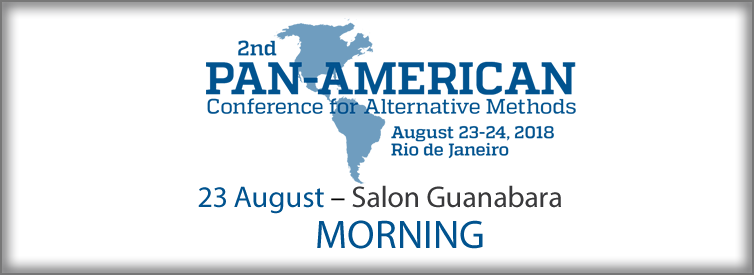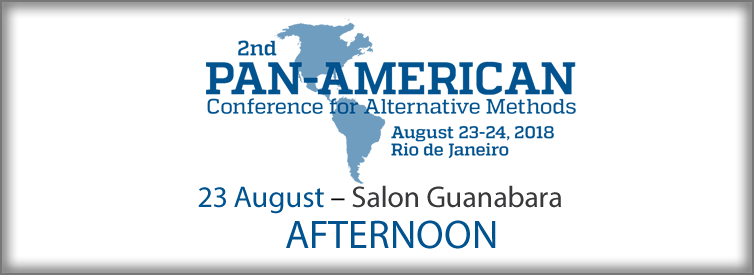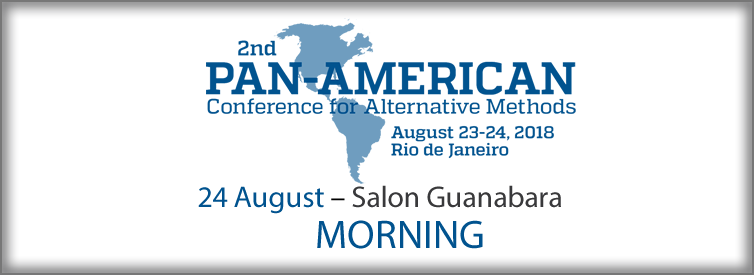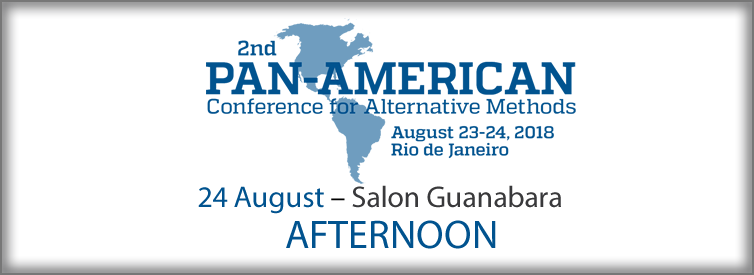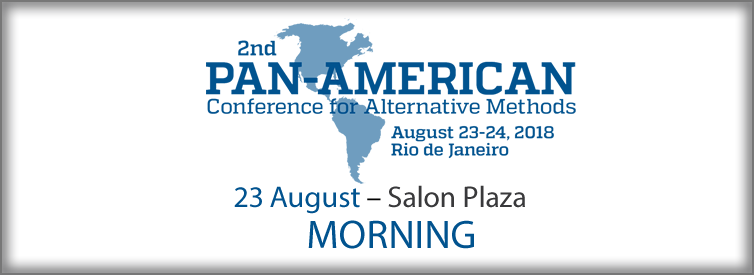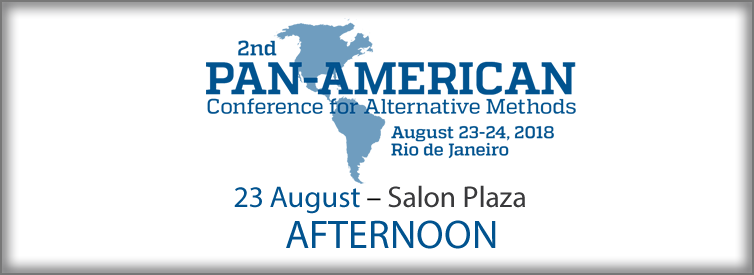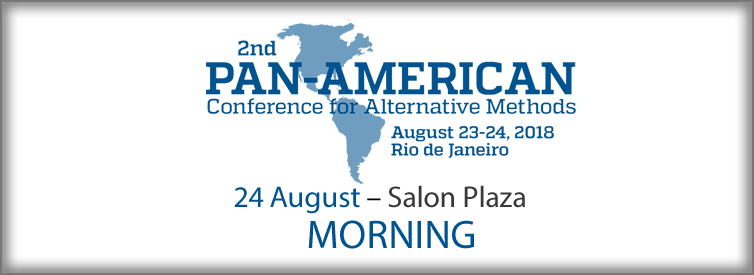Video Lectures
Salon Guanabara
Salon Plaza
Oral Presentation
Accepted abstracts for Oral and Poster Presentation – 2018 – July – 20th
Poster Presentation
Accepted abstracts for Poster Presentation – 2018 – July – 20th
|
2nd Pan-American Conference for Alternative Methods, 2018 WEDNESDAY, August 22nd |
||
| TIME | Local: Auditório I do Centro Brasileiro de Pesquisas Físicas (CBPF). R. Dr. Xavier Sigaud, 150 – Urca, Rio de Janeiro – RJ, 22290-180. |
| Pre-meetings | |
| 10:00 |
“Mini-course: Micronucleos in vitro: Applications and Challenges”. Dra. Izabel Villela (Inn VITRO P&D, Brazil). Free mini-course open to participants of 2nd Pan-American Local: Centro Brasileiro de Pesquisas Físicas (CBPF) – Auditório I – The course will be in Portuguese. |
| 13:00 | Lunch |
| 14:00 |
In vitro meeting – under invitation Centro Brasileiro de Pesquisas Físicas (CBPF) – Auditório I |
|
2nd Pan-American Conference for Alternative Methods, 2018 THURSDAY, August 23rd |
||
| TIME | ||
| Room 1 (180 seats) | Room 2 (80 seats) | |
| 08:00 | Reception / Badge | |
| 08:40 | Opening Welcome | |
| 09:00 |
Opening Ceremony – Thomas Hartung (CAAT – Johns Hopkins, USA) |
|
| Section I – Alternatives models for lung and skin. Chair: Silvya Stuchi (USP). | Section II – Round Table – Humane Education encouragement policies in Latin America. Chair: Róber Bachinski (1R Institute). | |
| 09:40 |
1. Pre-Validation of an Acute Inhalation Toxicity Assay Using the EpiAirway In Vitro Human Airway Model. Patrick Hayden (MatTek Corp). |
1. Róber Bachinski (1R Institute). |
| 10:00 |
2. A stochastic clonal selection for modeling intra tumor heterogeneity in human melanoma and clinical implications. Larissa A Carvalho (USP, SP). SECTION I_2_Larissa A. Carvalho .pdf |
2. Vanessa Bones (CRMV, PR – CONCEA Councillier). |
| 10:20 |
3. Potential use of skin bioprinting on cosmetics. Juliana Lago (Natura). SECTION I_3_Juliana Lago.pdf |
3. Thales Tréz (UNIFAL, MG).
|
| 10:40 |
4. Development of 3D bioprinted Reconstructed Skin models using native and non-native bioinks. Carolina Motter Catarino (Rensselaer Polytechnic Institute). SECTION I_4_Carolina Motter Catarino.pdf |
4. Rita Leal Paixão (UFF, RJ). / Replaced by Dr. Karynn Capilé. |
| 11:00 | coffee and poster session | coffee and poster session |
| Section III – In silico and Computational Toxicology. Chair: Thomas Hartung. | Section IV – Round Table – The development of new humane teaching methods. Chair: Nick Jukes (InterNiche). | |
| 11:30 |
1. A Defined Approach to Skin Sensitisation: Integrating Derek Nexus with In Chemico/In Vitro Assays Based on Exclusion Criteria. Donna S. Macmillan (Lhasa Limited, Leeds, UK). |
1. Nick Jukes (InterNICHE). (Replaced by Róber Bachinski). |
| 11:50 |
2. Challenges and opportunities for using AOP-based in silico models in regulatory contexts. Carlos Eduardo dos Santos, Altox. |
2. Simone Tostes (UFPR, PR). |
| 12:20 |
3. Best practices to develop artificial intelligence models for predicting multilevel effects in Adverse Outcome Pathways (AOP). Rodolpho C. Braga, Altox. |
3. Gutemberg Alves (UFF, RJ). |
| 12:40 |
4. Modeling the Complex Relationships Between Chemical Properties, Adaptive Response, and Oxidative Stress. Fjodor Melnikov (Yale University, USA). |
4. Maria Yanneth Torres Chaparro (UCC, Colômbia). SECTION IV_4_Maria Yanneth Torres Chaparro.pdf 5. Julia Maria Matera (USP, SP). |
| 12:50 |
5. Green Toxicology: Using big data on little chemicals to guide safe design. Alexandra Maertens (CAAT, Johns Hopkins, USA). |
6. Myocutaneous simulator for teaching suture and reconstructive surgery. Matheus Cruz (UFPR, PR). |
| 13:00 | Lunch | Lunch |
| Section V – Cosmetics and Fragrances: Progress and Challenges for the Future. Chair: Vanessa Rocha (Natura, SP). | Section VI – Animal protection and science advance. Chair: Norma Labarthe (FIOCRUZ, Brasil). | |
| 14:10 |
1. Safety assessment of cosmetics with no animal testing. Vanessa Rocha (Natura). |
1. Advancing Science Without Suffering in Brazil. Helder Constantino (Humane Society International, Brazil). |
| 14:30 |
2. Intensifying alternative methods for the application in the development of cosmetic projects. Marcio Lorencini (Boticário, PR). |
2. A new definition for animal-free testing. Replacing animal-derived components in regulatory in vitro methods. Carol Treasure (XCellR8, USA). |
| 14:50 | 3. Implementation, availability and regulatory status of an OECD accepted Reconstructed Human Epidermis model in Brazil. Rodrigo De Vecchi (L’OREAL, RJ). |
3. Implementation needs on alternative methods in Brasil: An animal protection perspective. Norma Labarthe (FIOCRUZ, RJ). |
| 15:10 |
4. How the fragrance industry engages in alternatives for animal testing. Matthias Vey (IFRA, (IFRA, Belgium). |
4. Round table and open microphone. |
| 15:30 | coffee and poster session | coffee and poster session |
| Section VII – Mini brains, Sensory Neurons and applications. Chair: Stevens Kastrup Rehen – UFRJ. | Section VIII – Legislation and Validation Centers. Chair: José Mauro Granjeiro (INMETRO/UFF) and Charu Chandrasekera (Canadian Center of Alternative Methods). | |
| 16:00 |
1. New insights about brain development using stem cells and organoids. Stevens Rehen. (UFRJ/IDOR, RJ). |
1.CONCEA Normatives and perspectives for 2019 and 2021 deadlines. Monica Andersen (CONCEA). SECTION VIII_1_Monica Andersen.pdf |
| 16:20 |
2. The application of Brain organoids to investigate CNS diseases and test drugs. Patrícia Braga (USP,SP). SECTION VII_2_Patricia Braga.pdf |
2. Contribution of BRACVAM and Validations on going. Octavio Presgrave (INCQS, RJ). SECTION VIII_2_Octavio Presgrave.pdf |
| 16:40 |
3. Potential applications of hiPSC-derived Peripheral Sensory Neurons in vitro models. Marilia P. Guimarães Zaluar (UFRJ/IDOR). SECTION VII_3_Marilia Zaluar Guimaraes.pdf |
3. New Canadian Centre for Alternatives: Vision & Strategy. (CCAAM). Charu Chandrasekera. (CCAM, Canada). |
| 17:00 |
4. A high content screening platform to evaluate viral infection in human brain cells. Karina Karmirian (iDor). SECTION VII_4_Karina Karmirian.pdf |
4. Round table and open Microphone. SECTION VIII_CHAIR VII_Jose Mauro Granjeiro.pdf |
| 17:20 | Plenary Lecture Jose Granjeiro (INMETRO, RJ) | |
| 18:00 | Get Together | |
|
2nd Pan-American Conference for Alternative Methods, 2018 FRIDAY, August 24th |
||
| TIME | ||
| Room 1 (180 seats) | Room 2 (80 seats) | |
| 09:00 | Plenary Lecture Vanessa Rocha (Natura, Brazil) | |
| Section IX – Human on a chip technology – Chair: Talita Marin (LNBIO, SP). | Section X – 3D Tissue Equivalents: Skin and Eye. Chair: Thomas Hartung. | |
| 09:40 |
1. Human on a Chip Systems as a Better Alternative to Determining Toxicity and Efficacy of Compounds Than Animal – James J. Hickman (University of Central Florida). |
1. Interlaboratory comparison of OECD TG 439 in Brazil. Luciene Ballotin (INMETRO). SECTION X_1_Luciene Ballotin.pdf |
| 10:00 |
2. Human on a chip plataform for sensitizer. Eduardo Pagani (CNPEN/LNBIO, SP). |
2. Animal-free safety assessment for children´s articles: the first successful implementation of Reconstructed Human Epidermis (RhE) model as an in vitro test for regulatory purposes in Brazil, Fabiana Medeiros (Biosintesis Laboratory). SECTION X_2_Fabiana Medeiros.pdf |
| 10:20 |
3. Microphysiological Systems (MPS): principles and applications to health science research. Talita M Marin (CNPEM/LNBio). SECTION IX_3_Talita Miguel Marin.pdf |
3. EpiOcular Eye Irritation Test (EpiOcular-EIT) for identification of materials not requiring classification and labeling for eye irritation or serious eye damage. Patrick Hayden (Mattek, USA). SECTION X_3_Patrick Hayden.pdf |
| 10:40 |
4. Implementation of human models on a chip: challenges and solutions. Margaret Magdesian (Ananda Devices,Canada). SECTION IX_4_Margaret Magdesian.pdf |
4. Corneal epithelium biomimetic model for eye toxicity testing to support innovation in Brazil. Artur CG da Silva (UFGO, GO). SECTION X_4_Artur CG da Silva.pdf |
| 11:00 | coffee and poster session | coffee and poster session |
| Section XI – Skin Sensitization: Are we ready for replacement? Chair: Marize Campos (UFG, GO). | Section XII – Vaccines: Making difference on reduction. Patrícia dos Santos Carneiro (Instituto Butantan , SP). | |
| 11:30 |
1. Implementation and Validation of Keratinosens, DPRA and HCLAT, Brazilian experience. Marize Campos (UFG, GO). SECTION XI_Chair XI_Marize Campos.pdf |
1. Alternative methods insertion into the QC lab routine: status and challenges. Patrícia dos Santos Carneiro (Instituto Butantan , SP). SECTION XII_CHAIR XII_Patricia dos Santos Carneiro .pdf |
| 11:50 |
2. The GARD assay for skin sensitization testing – validation, predictive performance and applicability for cosmetic ingredients. Andy Forreryd (Senzagen, Sweden). SECTION XI_2_Andy Forreryd.pdf |
2. Safety tests: MAT for Yellow-fever and meningococcal vaccines. Alessandra Santos Almeida (Biomanguinhos/Fiocruz, RJ). |
| 12:10 | 3. U-SENS, and OECD method, considered in a Non-Animal approach for predicting skin sensitization. Nathalie Alépée (L´Oréal Research and Innovation, France). |
3. In vitro alternatives for the in vivo rabies vaccine potency. Wlamir Correa de Moura (INCQS, RJ). SECTION XII_3_Wlamir Correa de Moura.pdf |
| 12:30 |
4. Assessment of skin sensitizing potential of UV-filters by a novel in vitro method based on DPRA. Lorena Rigo Gaspar (USP, SP). SECTION XI_4_Lorena Rigo Gaspar.pdf |
4. Validation of an in vitro assay for the detection of residual viable rabies virus in inactivated rabies vaccines. Beatriz Lourenco Correia Moreira (Instituto de Tecnologia do Paraná – TECPAR, PR). SECTION XII_4_Beatriz Lourenco Correia Moreira.pdf |
| 12:50 |
5. Use of the Caenorhabditis elegans as an alternative model for evaluating the allergen potential of skin sensitisers. Camila Braggion (UNIFESP, SP). SECTION XI_5_Camila Braggion.pdf |
5. Butantan experience on the in vitro alternatives for hyperimmune sera analysis: safety and potency tests. Eliana Blini Marengo (Instituto Butantan,SP). SECTION XII_5_Eliana Blini Marengo.pdf |
| 13:10 | Lunch | Lunch |
| Section XIII – Agrochemicals – Alternative Methods Approach Chair: Karen Cazarin (BASF). | Section XIV – New strategies for Efficacy and Safety in Cosmetics. José Mauro Granjeiro (INMETRO, RJ). | |
| 14:10 |
1. US/Canada approach on alternative method. Angela Hofstra (Syngenta, USA). SECTION XIII_1_Angela Hofstra.pdf |
1. Human organotypic skin explant culture (hosec): an alternative method for tropical diseases and cosmetic. Marco Andrey Cipriani Frade (HCFMRP-USP). SECTION XIV_1_Marco Andrey Cipriani Frade.pdf |
| 14:20 |
2. Industry approach on alternative methods- Andef Task Force – Andreia Latorre (Bayer Cropscience). SECTION XIII_2_Andreia Latorre.pdf |
2. Gene expression screening to identify activation profiles in skin after exposition to cosmetic ingredients. Daniela Zimbardi (Natura, SP). SECTION XIV_2_Daniela Zimbardi.pdf |
| 14:30 |
3. Skin irritation studies for agrochemicals registration: Comparison of in vitro and in vivo results. Diogo Zoltay Alvez (Mérieux NutriScience / Bioagri Laboratórios). SECTION XIII_3_Diogo Zoltay Alves.pdf |
3. Ex vivo skin model: an alternative tool for efficacy assessment. Michelle Sabrina da Silva (Kosmoscience Group). SECTION XIV_3_Michelle Sabrina.pdf |
| 14:50 |
4. Open Microphone. |
4. An Integrated Testing Strategy for in vitro Skin Corrosion and Irritation Assessment using SkinEthic Reconstructed Human Epidermis.Nathalie Alepee (L’OREAL, France). SECTION XIV_4_Nathalie Alepee.pdf |
| 15:30 | coffee and poster session | coffee and poster session |
| Section XV – Section XV – Alternative Methods initiatives in South America. Chair: Luciene Ballotin (INMETRO, RJ). | Section XVI – Other perspectives for Alternatives. Chair: Humberto de Mello Brandão (Empraba, MG). | |
| 16:00 |
1. Premasur, the MERCOSUR’s Platform for Alternative Methods. Luciene Ballotin (INMETRO). SECTION XV_1_Luciene Ballotin.pdf |
1. Hydra, a freshwater cnidarian, offers great potential as an alternative model organism for chemical risk assessment. Mohammad A. Akbarsha (Bharathidasan University, India). |
| 16:20 |
2. Alternative methods in Argentina: regulation, legislation and capacities for the incorporation of new methodologies. Maria Laura Gutierrez (Institute of Pharmacology, University of Buenos Aires). SECTION XV_2_Maria Laura Gutierrez.pdf |
2. Novel strategies for 3D cell culture & developmental tissue engineering. Leandra Baptista (INMETRO-UFRJ). SECTION XVI_2_Leandra Baptista.pdf |
| 16:40 |
3. Development of national capacities for the implementation of alternative methods: a new challenge in Uruguay. Mariela Bollati-Fogolín. Institut Paster de Montevideo. SECTION XV_3_Mariela Bollati-Fogolin.pdf |
3. New opacitometer for eye irritation to (OECD GT 437). Humberto de Mello Brandão (Empraba, MG). SECTION XVI_3_Humberto de Mello Brandao.pdf |
| 17:00 |
4. Get 2 for 1: A dual reporter cell line for simultaneous detection of substances with estrogenic and/or androgenic activity. Romina Pagotto. Institut Pasteur de Montevideo. SECTION XV_4_Romina Pagotto.pdf |
4. Zebrafish early-life stage as a refinement to predict acute oral toxicity. Lara Barroso Brito (UFG, Brazil). SECTION XVI_4_Lara Barroso Brito.pdf |
| 17:20 | Plenary Lecture Charu Chandrasekera (Canadian Centre for Alternatives to Animal Methods, Canada) | |
| 18:00 | Closing Ceremony – Poster Premium | |
